Physical Address
304 North Cardinal St.
Dorchester Center, MA 02124
The eye is a compact, complicated structure ( Fig. 391-1 ) that is remarkably stable throughout life. Once the growth of the eye is complete, at approximately age 7 to 8 years, the structure of the eye changes very little throughout one’s life.
The eyelids physically protect the eye. The pathway of light through the eye, termed the visual axis , ideally contains no opaque structures such as blood vessels. Light passes through the tear film, cornea, aqueous humor, crystalline lens, vitreous, and inner retina, all of which, except for the crystalline lens, remain essentially transparent throughout life. Delicate intraocular structures are protected by a tough collagenous “eye wall” composed of the cornea and sclera. The optic nerve, which is primarily composed of axons from the retinal ganglion cells, is enveloped by dura, arachnoid, and pia mater, which are contiguous with the dural layers of the brain. The myelination of the neural elements of the optic nerve begins at the posterior aspect of the eye. The orbital portion of the optic nerve is long enough to allow free excursions of the eye through a 100-degree arc under the influence of six coordinated and critically placed rectus muscles. All these functional components are housed in a bony cavity, the orbit, which protects the eye from external injury.
The eyelid skin, only loosely connected to underlying structures, is among the thinnest of the body. The eyelid is unique because it contains the highest density of sebaceous glands in the body. These meibomian glands produce a sebaceous (lipid) material that is the principal evaporation retardant for the tear film. Malorientation of the eyelid margin or malorientation of the lashes (trichiasis) may cause scarring of the anterior surface of the eye, even to the point of blindness, owing to diminished transparency of the cornea. The upper eyelid is opened by contraction of the levator muscle. The tendon of the levator tends to degenerate over time to produce mechanical ptosis (“drooping eyelids”). The soft tissue of the eyelid is separated from the soft tissue of the orbit by the orbital septum, a major collagenous barrier that protects intraorbital soft tissue from extension of preseptal eyelid inflammation and infection. Extension of inflammation from preseptal cellulitis or ethmoiditis may cause orbital cellulitis, thereby resulting in potential consequences such as cavernous sinus thrombosis. The elastic tissue supporting the skin of the anterior eyelid is reduced over time, thereby causing dermatochalasis (“baggy eyelids”). Redundant tissue of the superior eyelid may be sufficient in quantity to restrict the visual field.
The conjunctiva is a mucous membrane with an outer layer of stratified, nonkeratinizing squamous epithelium containing goblet cells. The epithelium is supported by delicate fibrovascular tissue that contains lymphatic channels. The conjunctival epithelium also contains melanocytes. Squamous carcinoma or malignant melanoma originating in the conjunctiva may extend through these channels to regional lymph nodes or beyond. Immune processing cells are present in the epithelium (Langerhans cells) and in the stroma as collections of non-nodal B and T lymphocytes. Non-nodal primary lymphomas, which tend to have an indolent course in this location, may arise from this tissue. The aqueous portion of tears is formed constantly by accessory lacrimal glands in the conjunctiva as well as by reflex action from the lacrimal gland. Symptoms of itching and burning, as well as periodic disturbance of vision, may result from inadequacies of the tear film layer.
Tears drain through two puncta located at the nasal eyelid margin (one in the upper lid and one in the lower lid) into the nasolacrimal duct, which exits into the nasal cavity under the inferior turbinate. The epithelium of the nasolacrimal duct also contains melanocytes and is supported by a resting lymphocyte population. Neoplasms including lymphoma, concretions (dacryoliths), and tissue injury from trauma may occlude the puncta and nasolacrimal system in adults.
The cornea is avascular and lined anteriorly by epithelial cells and posteriorly by endothelial cells. Lack of an adequate tear film (dry eye syndrome) may seriously alter the ability of the cornea to transmit light, thereby affecting visual acuity. The posterior cellular lining of the cornea is a single layer of highly modified corneal endothelial cells that maintain tissue dehydration. Lack of effective pumping by the endothelial cells will allow excess hydration of the corneal stroma—that is, corneal edema—which diminishes the transmission of light. The corneal stroma is particularly sensitive to proteolysis from collagenases found with certain inflammatory conditions, such as herpes simplex and zoster keratitis. The cumulative effect of multiple episodes of corneal inflammation may be thinning and even perforation of the cornea or, alternatively, thickening and scarring.
The anterior chamber is bounded by the posterior surface of the cornea, the anterior surface of the iris, and the anterior surface of the crystalline lens within the pupillary space. The posterior chamber is bounded by the posterior surface of the iris, the ciliary body circumferentially, and the anterior surface of the vitreous. Aqueous humor normally flows from the posterior chamber into the anterior chamber through the pupil and exits into the general circulation through the trabecular meshwork and a series of collector veins. Most causes of pathologically increased intraocular pressure and optic nerve damage (e.g., glaucoma) are due to abnormalities of filtration through the trabecular meshwork. The crystalline lens is located entirely in the posterior chamber.
The anterior segment is composed of the cornea and the anterior and posterior chambers. Most of the anterior segment is derived from the skin and neural crest tissue. The posterior segment is the remainder of the eye. Most of the posterior segment structures are derived from the central nervous system and neural crest tissue.
When first formed, the crystalline lens is a totally cellular structure bounded by a true basement membrane. Throughout life, the new cells that are continuously added from the outer-layer epithelial cells compress the central cells, thereby resulting in cell degeneration in the central core (nucleus). The lens doubles in volume from birth to age 70 years at the cost of both pliability (presbyopia) and clarity (cataract). The lens is suspended in the posterior chamber by fibers (zonules) attached to the ciliary body.
The ciliary body comprises the middle layer of the eye wall, the uveal tract. The uveal tract extends under the retina as a vascular plexus, the choroid, and the iris. The surface cells of the ciliary body produce aqueous humor, and its muscles function in accommodation.
The vitreous is composed primarily of water and type II collagen. The vitreous makes up the majority of the volume and weight of the eye. It functions as a biochemical sink as well as to maintain neural retinal attachment. With time, the vitreous shrinks and separates from the retina (posterior vitreous detachment). Condensed vitreous opacities, which cast shadows on the retina, are perceived by the patient as “floaters.”
The retina is the site of photochemical conversion of light to electrical energy. Ganglion cells and their axons in the internal retina aggregate at the optic disc to form the optic nerve. Only the inner half of the retina is supplied by intraretinal vessels that are seen by ophthalmoscopy. The outer half of the retina is supplied by large-caliber capillary vessels in the choroid (the choriocapillaris). Extensive biochemical support and control of stray light are performed by the retinal pigment epithelium located between the choriocapillaris and the photoreceptor outer segments. The density of photoreceptor cells (rods and cones) varies across the retina. Only a 500-µm area of the posterior retina, the central macula (about 3 to 5% of the total retina), has a high enough density of photoreceptor cells, primarily cones, to allow images to be resolved to 20/20. The remainder of the retina has much less sensitive image resolution owing to a lower density of photoreceptor cells. The blood-retinal barrier, which protects the biochemical integrity of the retina, is composed of anatomic attachments between neighboring retinal pigment epithelial cells, as well as attachments between vascular endothelial cells of the retinal circulation. The retina is held in place by physiologic forces that may be compromised by holes in the retina (rhegmatogenous retinal detachment) or by fluid accumulating in the subretinal space without a retinal hole (nonrhegmatogenous retinal detachment).
The optic nerve is composed of approximately 1 million axons from retinal ganglion cells. Axons are separated into bundles by pial septa, which are in turn enclosed in an arachnoid layer. The dura is contiguous with the posterior sclera and the periosteum of the optic canal. Delicate vessels extending from the dura across the arachnoid to the pial septa supply the optic nerve. The central retinal artery is present in the axial layer of the optic nerve near the eye but does not supply blood to the optic nerve itself. The optic nerve axons travel through a collagenous sieve in the plane of the posterior sclera, the lamina cribrosa. The choroid is that portion of the uveal tract external to the retina. This layer is composed of various calibers of blood vessels that ultimately supply blood for the choriocapillaris.
The sclera is composed of dense, relatively disorganized collagen. It is opaque because of the nonhomogeneous structure of the collagen and the degree of hydration relative to the cornea. There are multiple scleral ostia for the passage of arteries, veins, and nerves, both posteriorly and anteriorly.
The orbit is composed of bones of the facial skeleton. Sutures between major bones exist in the superior nasal and superior temporal quadrants. Multiple vessels and nerves extend through the thin ethmoid bone from nasal sinus tissue medially. The orbital floor, which is a relatively thin layer of bony support over the maxillary sinus, may rupture with increased intraorbital pressure or after blunt trauma to the inferior orbital rim. The nasolacrimal duct travels through a portion of the lacrimal bone. Portions of the sphenoid bone protect the optic nerve. Major cranial nerves travel through the adjacent superior orbital fissure, also a portion of the sphenoid bone. There is no normal lymphoid tissue in the orbit outside of the lacrimal gland. The rectus muscles may be enlarged by inflammation in thyroid eye disease, but the tendinous insertion into the sclera is usually not inflamed early in the course of the disease.
Patients may present with complaints of diminished vision, eye pain, redness, or pain around the eye. The causes may be primarily ophthalmic (e.g., cataract) or systemic (e.g., diabetic retinopathy). A comprehensive ophthalmologic examination also should evaluate for possible asymptomatic local (e.g., choroidal melanoma) or systemic (e.g., hypertensive retinopathy) abnormalities in patients with normal acuity and no subjective complaints.
The most objective and common measure of ocular function is line letter acuity, with normal vision ( Table 391-1 ) defined as the ability to see at 20 feet what a normal person sees at 20 feet, known as 20/20 vision ( E-Fig. 391-1 ). Less than 20/20 vision can be caused by an abnormality anywhere from the tear film to the visual cortex of the occipital lobe (see Fig. 391-1 ). However, normal vision also includes other functions, such as the perception of color, motion, contrast, brightness, field, and depth, for which there is greater variation among individuals. Normal visual acuity is potentially achievable in essentially all individuals, either naturally or with the correction of the refractive error. Although effective treatments are available for refractive errors, cataracts, glaucoma, and other eye conditions, there is no evidence that routine screening for impaired visual acuity is associated with improved clinical outcomes.
| 20/20 | Physiologic vision |
| 20/30-20/100 | Driver’s license, varies by state |
| 20/50 | Newspaper print |
| 20/70 | Large-print Reader’s Digest |
| 20/100 | Check writing |
| 20/200 | Legal blindness |
| 20/400 | Paper currency |
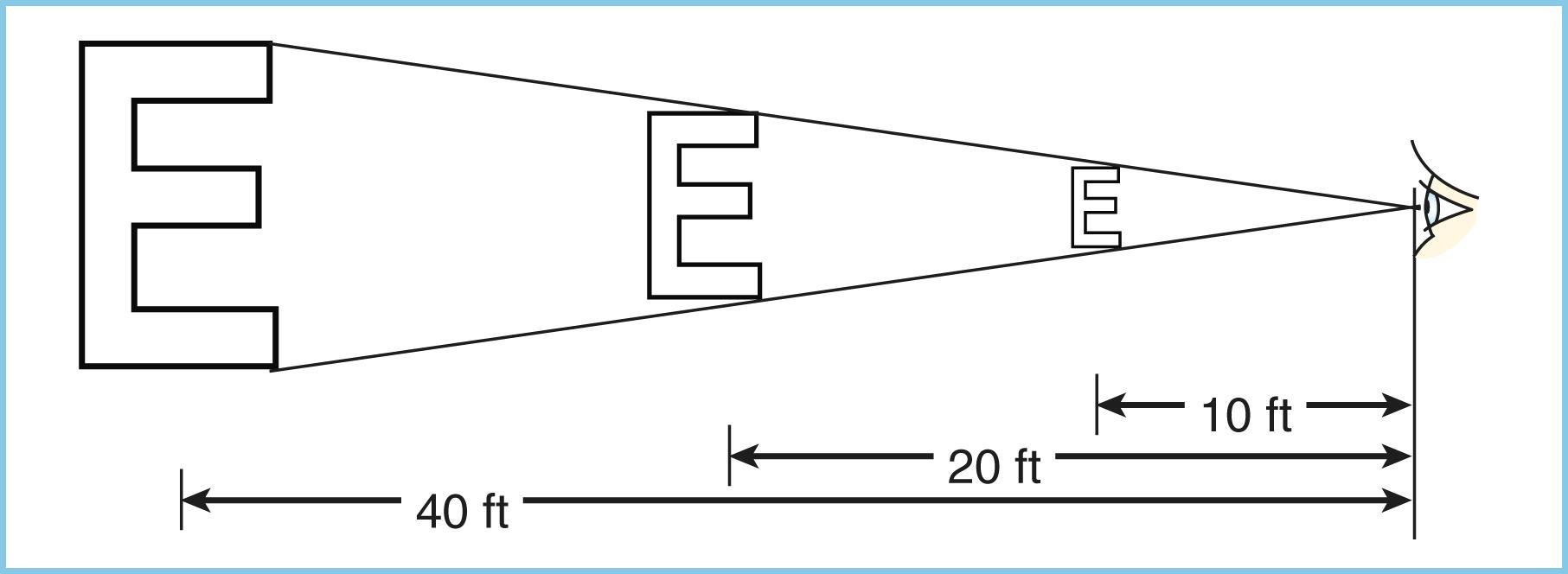
Correction of vision is based on the refraction of light ( Fig. 391-2 ). The diopter (D) is the unit of measurement of the ability of an optical system to refract (bend) light. The normal human eye has a refractive capacity of approximately 60 D, which is accomplished by the cornea and the crystalline lens. This refractive capacity is needed to focus light onto the central retina, the macula. If the eye is too short, light will be focused behind the eye (hyperopia). If the eye is too long, light will be focused in the vitreous cavity in front of the retina (myopia). Normally, a person can involuntarily control the crystalline lens, alternating between near and distant tasks. During the fourth and fifth decades of life, the lens becomes less pliable and the eye loses its ability to alter its shape (presbyopia). Refraction is the method of determining the amount of optical correction (strength of glasses) needed to establish 20/20 vision.
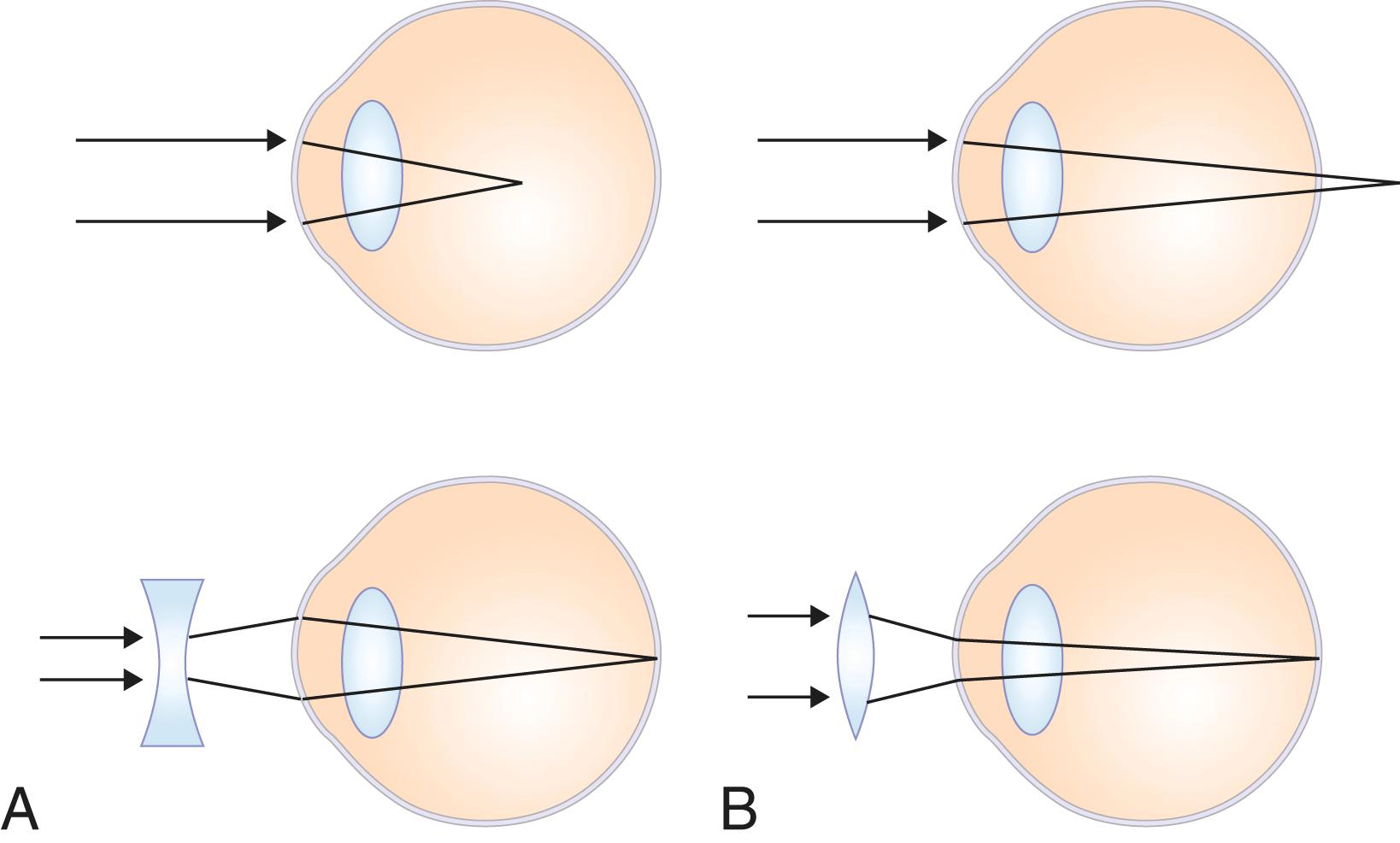
Examination of pupillary response assesses whether neural function is intact (see Figs. 392-2 and 392-4 ). Confrontational visual field testing (see Fig. 392-1 in Chapter 392 ) should be performed in each eye to detect gross quadrantic defects. Extraocular motility should be assessed to exclude nerve or muscle abnormalities (see Table 392-6 ). Color vision testing plates are a sensitive indicator of optic nerve function and for detecting genetic variations that result in deficiencies of color perception.
Diagnostic testing during a routine eye examination also includes external examination of the lids and adnexa, applanation tonometry to determine intraocular pressure, biomicroscopy (slit lamp examination) of the anterior segment, and ophthalmoscopic examination of the ocular fundus (the retina and associated structures). Other tests include exophthalmometry (measurement of proptosis), visual field and electrophysiologic testing and imaging (fluorescein angiography, mainly in diabetic patients; optical coherence tomography [OCT] to investigate retinal disease and glaucomatous damage), and corneal topography.
The conjunctiva, cornea, lens, and anterior chamber are evaluated using a slit lamp biomicroscope. The slit lamp is composed of a binocular microscope with variable magnification (40× and 80×) in conjunction with adjustable light sources. An increased concentration of protein can be detected in the anterior chamber because of the Tyndall (flare) effect, indicating vascular incompetence associated with either inflammation or ischemia. Even individual inflammatory cells can be resolved with the slit lamp. A cobalt blue filter can be used to detect fluorescein dye that accumulates in regions of abnormal epithelium (dendrite of herpes simplex keratitis or a corneal abrasion). The slit beam is used to examine the crystalline lens to determine the depth of the anterior chamber and the degree of opacification from a cataract. By using a green filter with the 90-D lens, the retinal vessels and retinal vascular abnormalities such as microaneurysm can be seen.
nearsightedness. Nearsightedness (myopia; see Fig. 391-2 ) is usually discovered during childhood when children cannot perform distant tasks during school (reading the blackboard) or during school screening. Myopia usually progresses until age 20 to 25 years. Rapidly progressing myopia at any time after age 25 years requires evaluation for diabetes mellitus (reversible metabolic changes in the crystalline lens), trauma (development of a cataract), or use of corticosteroids (development of a cataract).
Nonpathologic forms of myopia are usually fully correctable with eye glasses or contact lenses or can be corrected to a visual acuity of 20/40 or better in 95% or more of patients by various forms of laser-assisted in situ keratomileusis (LASIK). Complications of LASIK include glare symptoms, dry eye, and undercorrection or overcorrection. Rare but serious complications include epithelial ingrowth, diffuse keratitis, and flap dislocation. For the prevention of myopia, children can be exposed to repeated low-level red light or be given 0.05% atropine eye drops nightly.
pathologic myopia. Pathologic myopia is a partly heritable condition causing progressive weakening of the posterior sclera and resulting increases in the axial length of the eye. Localized areas of deformation arise where there is an abrupt increase in the posterior radius of curvature of the eye (posterior staphyloma). The axial length of a normal eye is typically between 20 and 24 mm, whereas it can increase to above 25 mm in pathologic myopia and may be as high as 40 mm in severe cases. Abnormal physical forces in pathologic myopia may lead to retinal hole formation, retinal detachment, choroidal neovascularization, or intraocular hemorrhage. Associated systemic conditions include Cornelia de Lange syndrome, Stickler syndrome, and Marfan syndrome. Clinical surveillance is important to identify treatable complications such as retinal holes and detachment.
Pathologic myopia is treated palliatively with eye glasses or contact lenses. Refractive procedures are less successful in pathologic myopia because of the severity of the refractive errors and the presence of posterior segment abnormalities. Surgical and laser procedures may be required to treat retinal and choroidal lesions.
In hyperopia (farsightedness; see Fig. 391-2 ), in contrast to myopia, the eye tends to have a shorter than average axial length. Shorter axial lengths are associated with narrow-angle glaucoma and angle-closure glaucoma. Compensatory mechanisms of the crystalline lens may functionally correct small degrees of hyperopia until age 40 years, when the crystalline lens loses its pliability. The initial pair of glasses may have to correct for both distance and near tasks (bifocals). Refractive surgical procedures can correct up to 5 D of hyperopia.
Presbyopia typically presents in the fourth to sixth decades of life and manifests as a progressive decrease in the ability to focus clearly on near objects. Presbyopia results when the crystalline lens loses its pliability, thereby preventing light rays from close objects from focusing onto the retina. The lens is suspended by fibers (zonules) attached to the ciliary body. In youth, the musculature of the ciliary body, acting via the zonules, alters the shape of the lens to provide increased near focusing power. As the lens hardens and presbyopia ensues, symptoms include difficulty reading small print, eyestrain, headaches, and the inability to read material unless it is farther away. Treatment is typically with eye glasses, such as bifocals, to provide adequate magnification to replace the lost ability of the eye.
Astigmatism derives from changes in the radius of curvature of the cornea and from the lens. Symptoms are predominantly blurry vision with “shadowing” and difficulty seeing fine detail. Regular astigmatism is not a pathologic state but rather a variation in anatomy; most people have some degree of regular astigmatism that can be corrected with eye glasses or contact lenses. Irregular astigmatism is usually from changes on the cornea (e.g., from scarring owing to infections or trauma) or from adjacent tissue on the cornea (e.g., pterygia or limbal masses that induce changes in the corneal curvature). Some forms of regular astigmatism can be corrected with corneal laser ablation, but irregular astigmatism often requires correction with rigid contact lenses.
Keratoconus is an acquired thinning of the cornea that induces irregularities of the corneal surface and irregular astigmatism; its cause is controversial but probably is partly genetic. Chronic eye rubbing has been associated with progressive disease. Onset generally is during adolescence, and the process often evolves over 5 to 10 years. The prevalence in the United States is approximately 55 cases per 100,000, but this figure may underestimate subclinical cases. Corneal surface mapping allows earlier and more precise diagnosis.
Patients with keratoconus typically report a progressive worsening of vision, sometimes severe. The condition is usually bilateral but not symmetrical. Mild degrees of early keratoconus can be corrected with glasses or contact lenses. The condition is typically progressive, but corneal collagen cross-linking can halt the progression in early to moderate cases and provide a sustained improvement in vision. For severe cases with significant corneal scarring and intolerance to contact lenses, corneal transplantation (graft) is the primary therapy.
The control of simultaneous orientation of the two eyes to ensure that the visual axes of both eyes are aligned is not complete until 6 to 12 months following birth. Misalignments of the two eyes (strabismus) may be the result of abnormalities in the central oculomotor nuclei of the brain, malfunction of one or several oculomotor nerves, or intrinsic abnormalities of the rectus or oblique muscles (see Fig. 392-6 ). If the eyes are not simultaneously stimulated with the images of the same degree of clarity or complexity, there is a risk that only one eye will develop normal vision (amblyopia). In most cases, only the central vision is affected, so the peripheral vision in both eyes is likely to be normal. Binocular vision can be disrupted with amblyopia, with a loss in depth perception that may become permanent if the normal eye alignment is not restored.
Amblyopia also may be caused by a marked difference in refractive error between the two eyes (anisometropic amblyopia), congenital cataracts, or eyelid ptosis (deprivational amblyopia). Ptosis may be neurogenic or mechanical (e.g., congenital eyelid hemangioma). To avoid amblyopia, it is extremely important to refer a child with strabismus to an ophthalmologist as soon as the strabismus is noted.
Esotropia is a deviation of one eye inward (“crossed eyes”). Although intermittent esotropia may be a normal finding in infancy, it should not be present beyond 6 months of age. Delay in facial maturation (underdeveloped nasal bridge) may give the appearance of esotropia, even though the visual axes are correctly aligned. In true strabismus, the corneal light reflex will be in the center of one cornea and decentered in the other.
Exotropia is deviation of one eye outward. Exotropia is often intermittent and less likely to result in amblyopia compared to esotropia. Like esotropia, intermittent exotropia may also be a normal developmental finding in infancy.
Treatment options for amblyopia include patching or atropine eye-drops (1%, typically daily but effective if used as infrequently as twice per week) to blur the better-seeing eye, thereby strengthening the amblyopic eye. These therapies have been shown to be equally effective in providing good vision if patients are treated before age 7 years. The outcome of treatment is more favorable if amblyopia is detected before age 2 to 3 years but may be occasionally successful into the teenage years depending on the severity. Success is directly related to compliance and the timeliness of diagnosis.
In some cases, esotropia or exotropia may be treated by using appropriate corrections of refractive error with glasses (occasionally bifocals). It is critically important to recognize that strabismus may be the presenting sign of vision loss due to other causes (e.g., retinoblastoma). Extraocular muscle surgery may be necessary to correct alignment.
Acute onset of diplopia is an ominous sign suggestive of a cranial nerve palsy (i.e., III, IV, or VI) or pathology in the orbit ( Chapter 392 ). Diplopia of any kind is usually an intolerable symptom, which is often worse with vertical deviations than horizontal deviations.
Most cases of congenital color blindness are genetically determined and go undetected for many years. Acquired color deficiency at any age may be caused by a cataract or optic nerve disease.
If only one eye has a change in vision, the problem, such as a cataract or retinal detachment, is most likely in that eye. If both eyes have a change in vision, the problem generally is outside of the eye, such as homonymous hemianopia ( Chapter 392 ). Improvement of near vision in middle age may be a sign of cataract (“second sight”) or hyperglycemia. Transient complete or partial unilateral or bilateral loss of vision may be caused by vascular abnormalities inside or outside of the eye ( Table 391-2 ).
| UNILATERAL | BILATERAL |
|---|---|
| Amaurosis fugax (carotid artery stenosis or vascular occlusion) Central retinal artery occlusion Occipital lobe infarct Temporal arteritis Nonarteritic anterior ischemic optic neuropathy Hemorrhage
Trauma |
Eclampsia Vertebrobasilar infarct Trauma |
The most severe eye pain ( Table 391-3 ), typically associated with a red eye, is caused by acute angle-closure glaucoma. Sharp, intermittent pain is usually caused by ocular surface abnormalities (e.g., corneal foreign body). Burning pain that clears with blinking generally relates to tear film abnormalities (dry eyes). Deep boring pain most often is associated with an ocular abnormality (e.g., uveitis).
| Blepharitis Blocked tear duct Chalazion Conjunctivitis Corneal abrasion Dry eyes Ectropion Entropion Foreign object |
Glaucoma Hordeolum (stye) Iritis Keratoconus Optic neuritis Scleritis Trauma Uveitis |
A red or inflamed eye can be caused by conjunctivitis (allergic, inflammatory, or infectious), iritis (anterior uveitis), acute glaucoma, ocular trauma, or infection ( Table 391-4 ). All of these causes are typically painful to varying degrees.
| FEATURE | ACUTE CONJUNCTIVITIS | ACUTE IRITIS † | ACUTE GLAUCOMA ‡ | CORNEAL TRAUMA OR INFECTION |
|---|---|---|---|---|
| Incidence | Extremely common | Common | Uncommon | Common |
| Discharge | Moderate to copious | None | None | Watery or purulent |
| Vision | No effect on vision | Slightly blurred | Markedly blurred | Usually blurred |
| Pain | None | Moderate | Severe | Moderate to severe |
| Conjunctival injection | Diffuse: more toward fornices | Mainly circumcorneal | Mainly circumcorneal | Mainly circumcorneal |
| Cornea | Clear | Usually clear | Steamy | Change in clarity related to cause |
| Pupil size | Normal | Normal or small | Moderately dilated and fixed | Normal or small |
| Pupillary light response | Normal | Normal or reduced | None | Normal |
| Intraocular pressure | Normal | Variable | Elevated | Normal |
| Smear | Causative organisms | No organisms | No organisms | Organisms found only in corneal ulcers related to infection |
∗ Less common causes of red eyes include endophthalmitis, foreign body, episcleritis, and scleritis.
Distorted vision (metamorphopsia), which is the perception that straight lines are distorted or bowed, results from macular dysfunction. Causes include fluid under the retina; macular degeneration, which tends to elevate the retina; and an epiretinal membrane, which tends to contract the retina.
Retinitis pigmentosa, vitamin A deficiency, and systemic medications such as phenothiazines can cause true night blindness, in which patients have difficulty seeing any stars in the sky on a clear night and may be unable to ambulate without assistance in a dark environment. Patients with cataracts may have difficulty driving at night because of excessive glare and visual distortion. Gene therapy using adeno-associated virus vectors carrying the RPE65 gene has been shown to increase retinal sensitivity and to improve night vision in patients with retinitis pigmentosa.
The sudden onset of flashes (photopsia) in the peripheral visual field suggests traction of the vitreous on the peripheral retina, sometimes with a resulting retinal tear. The flashes, which may be more pronounced in the dark and with rapid eye movement, may be associated with the sudden onset of floaters, which can indicate debris or blood in the vitreous cavity. Because a tear in the retina can lead to a retinal detachment, urgent consultation with an ophthalmologist is required.
Flashing light with a migraine ( Chapter 367 ) is described as scintillations or zigzagging lights that march across the visual field for a few minutes or as long as 30 minutes, sometimes associated with transient visual field loss. Headache is not universal.
Floaters, which are caused by small aggregates or opacities in the vitreous cavity, result from the normal aging of the vitreous. The acute onset of vitreous floaters may be associated with uveitis or with the sudden onset of bleeding in the vitreous cavity owing to diabetes or vascular occlusions. Acute floaters, however, particularly if associated with flashing lights, may indicate a posterior vitreous detachment and/or a retinal tear with an impending retinal detachment. Urgent ophthalmic referral is essential.
Photophobia, particularly if associated with eye pain, redness, and decreased vision, is a symptom of intraocular inflammation (uveitis) from trauma or other causes. Photophobia is also typical of acute migraine and meningeal irritation. Prompt ophthalmologic referral is prudent.
Patients with cataracts commonly see halos around lights, particularly when driving at night. Episodic decreased vision, redness, and halos around lights may be symptoms of impending angle-closure glaucoma owing to increased intraocular pressure with resulting corneal edema and loss of corneal clarity. Halos also can occur as a complication of refractive eye surgery.
A foreign body sensation is commonly caused by ocular surface diseases such as dry eye syndrome (see later). Entropion (see Fig. 391-3 ) or misdirected lashes (trichiasis) also can cause a foreign body sensation. Most corneal abrasions cause severe pain, but minor corneal abrasions may be associated with a foreign body sensation rather than the severe pain. An arc welder burn causes a punctate corneal keratopathy, and foreign body sensation may be a prominent symptom. A true conjunctival or corneal foreign body also may be present.
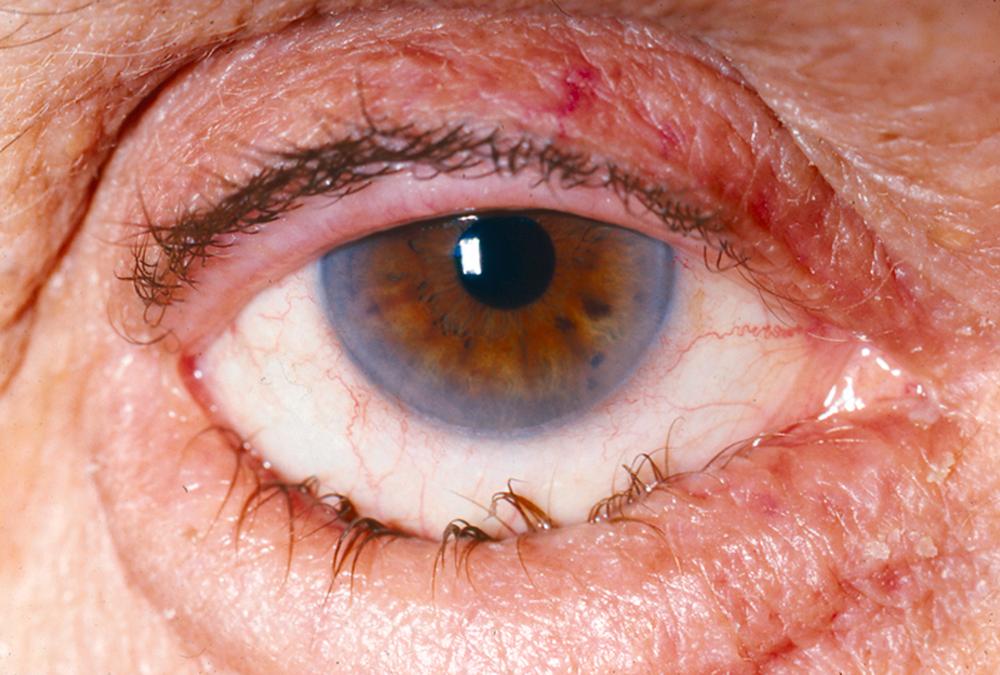
Tearing can occur because of the overproduction of tears or impairment of tear drainage. Any abnormalities in upper or lower lid laxity, position, or closure can impair the lacrimal pump system. The most common cause of epiphora is chronic or acute irritation that results in the overproduction of reflex tearing from ocular dryness (dry eye syndrome). Ocular surface irritants, such as trichiatic eyelashes touching the cornea, also can stimulate excessive tear production. Obstruction of the nasolacrimal tear drainage system owing to age, inflammation, infection, trauma, or neoplasm can prevent appropriate tear drainage. Treatment depends on the underlying condition.
Any irritation of the conjunctiva or cornea can cause the eyelids to twitch. Occasional twitching of the lids usually is associated with stress or adrenergic stimulation. Benign essential blepharospasm is severe spasm of the lids leading to functional impairment. Multiple sclerosis ( Chapter 380 ) also can cause lid spasm.
Any ocular inflammation, including corneal ulcers, angle-closure glaucoma, endophthalmitis, and uveitis, can be associated with secondary conjunctival hyperemia. Conjunctivitis usually involves the entire conjunctiva, is associated with a discharge, and may or may not be associated with pain (see Table 391-4 ).
Ptosis ( Fig. 391-4 ) is typically due to age-related degeneration and even disinsertion of the levator palpebrae superioris muscle. However, it also can be caused by a third nerve palsy, Horner syndrome, myasthenia gravis ( Chapter 390 ), or other neurologic conditions. Third nerve palsy is usually associated with diplopia and a large pupil. Horner syndrome (see Fig. 392-5 ) is associated with a small pupil and ipsilateral anhydrosis. With myasthenia gravis ( Chapter 390 ), other typical features of muscle weakness and fatigability are usually present or can be elicited. Non-neurologic causes of ptosis include age-related dehiscence of the levator muscle.
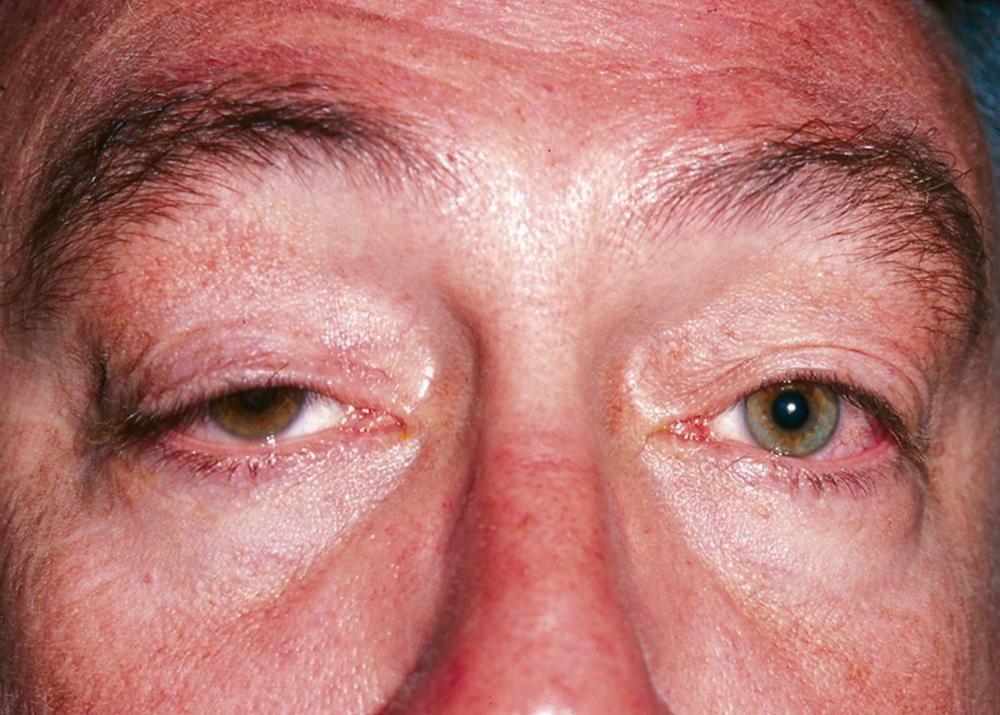
Proptosis, or a prominent globe, can be a manifestation of thyroid eye disease, which in turn is associated with thyroid abnormalities, especially Graves disease ( Chapter 207 ). In this setting, proptosis can be subacute and asymmetrical. Any orbital inflammation, infection, or neoplasm can cause unilateral proptosis; in the case of inflammation or infection, proptosis is typically acute in onset. All orbital processes can affect orbital cranial nerves, with associated diplopia or optic neuropathy. Orbital infection, or cellulitis, typically presents with concurrent severe eye redness, pain, sinusitis, and an elevated white blood cell count ( Fig. 391-5 ). Idiopathic orbital inflammation can cause acute, usually unilateral proptosis, with severe pain, particularly with eye movement, and often with decreased vision. An optic nerve tumor causes chronic, unilateral proptosis associated with a slow onset of visual field loss. Acute cellulitis can be associated with unilateral proptosis, severe redness, and moderate to severe pain, commonly with sinusitis and an elevated white blood cell count.
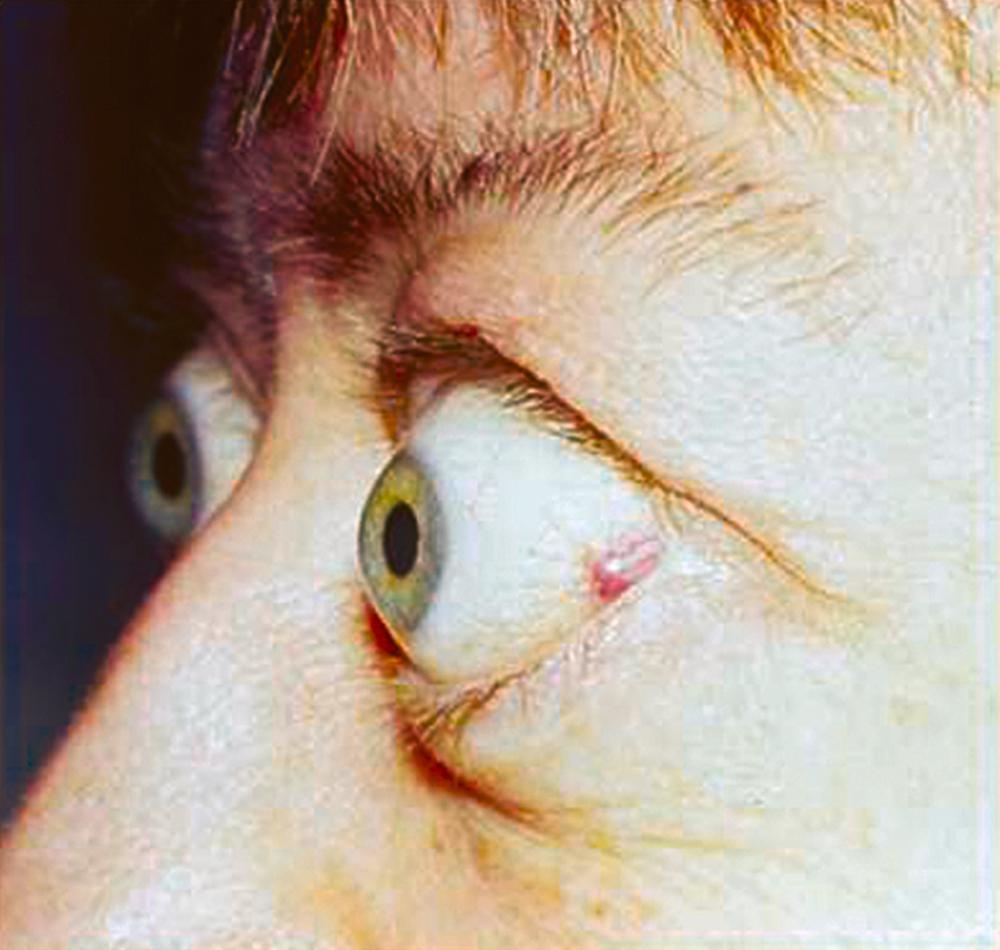
A unilateral small pupil is best detected in dark conditions. Causes include Horner syndrome, associated with ptosis on the same side; the bilaterally small, poorly reacting pupils of tertiary syphilis (Argyll Robertson pupils), which accommodate with normal constriction to a near object; miotic drops (e.g., pilocarpine); traumatic iritis; uveitis; and opioids.
Any α-adrenergic or anticholinergic agent placed into the eye can cause a large pupil. With eye trauma, the iris sphincter muscle can be damaged, and an abnormally large pupil can result. Tears in the iris sphincter can sometimes be appreciated on slit lamp examination. Third nerve palsy may cause a dilated pupil associated with ptosis and decreased elevation, depression, and medial eye movement. Adie pupil (see Fig. 396-3 ) is an idiopathic, unilateral large pupil that is hypersensitive to weak cholinergic stimulation. Recent eye surgery with pharmacologic dilation, uveitis, an acute angle-closure glaucoma attack, and traumatic iritis can cause a large pupil.
Leukocoria (white pupil) in a young child is critically important, because it may be a sign of retinoblastoma. Some of the more common non-retinoblastoma conditions presenting with leukocoria ( Table 391-5 ) include cataracts, retinal detachment, persistent fetal vasculature (a developmental anomaly of the vitreous resulting in intraocular fibrosis and retinal detachment), Coats disease (a developmental vascular malformation of the retina leading to exudative retinal detachment), and ocular toxocariasis (a parasitic intraocular nematode infection that leads to intraocular scarring and retinal detachment).
| Retinoblastoma |
| Cataract |
| Persistent hyperplastic primary vitreous |
| Retinopathy of prematurity (retrolental fibroplasia) |
| Coats disease (retinal telangiectasia) |
| Retinal detachment |
| Toxocariasis |
| Familial exudative vitreoretinopathy (FEVR) |
An ectropion is an out-turning of the eyelid, typically the lower lid ( Fig. 391-6 ), with exposure of the undersurface of the lid. Causes include aging, scarring, a mass on the eyelid, and seventh nerve (Bell) palsy. Common symptoms, which derive from corneal exposure and drying, include burning, itching, tearing, and the sense of a foreign body. Treatment is surgical, although mild symptoms may be managed conservatively with lubrication.
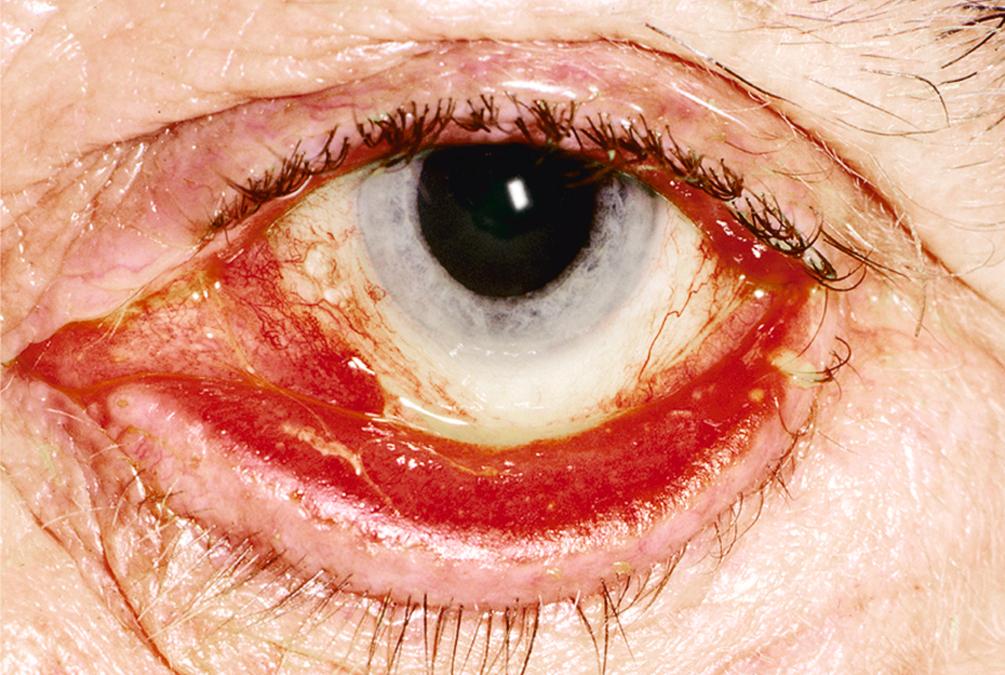
An entropion, which is an in-turning of the eyelid (see Fig. 391-3 ), is usually age related and associated with irritation, burning, and a foreign body sensation because the eyelashes touch the cornea. If it leads to trichiasis, in which the eyelashes rub or abrade the cornea, the lashes can be removed with forceps or surgery to correct the eyelid malposition. Botulinum toxin can be injected into the orbicularis muscle to temporarily correct the entropion.
A chalazion ( Fig. 391-7 ) is a localized lipogranulomatous inflammation owing to an occluded sebaceous (meibomian) gland. The retained, lipid-rich sebaceous material acts as a foreign material that stimulates a lipogranulomatous foreign body inflammatory reaction. A painless or slightly tender, nonmobile nodule forms under the eyelid skin. Most lesions resolve over days to weeks with warm compresses or without specific treatment. If the chalazion persists, it may be surgically débrided. Some individuals may have recurrent chalazia. A recurrent chalazion in the same spot may point to an underlying carcinoma.
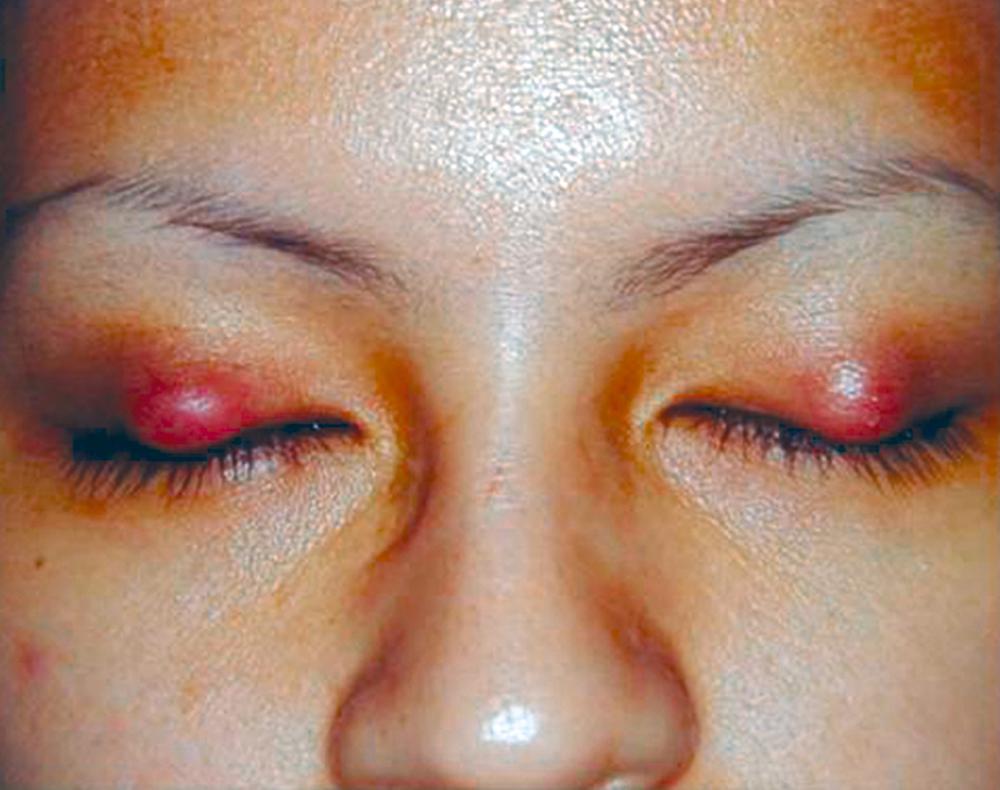
A hordeolum (stye) ( Fig. 391-8 ) is a painful abscess in a hair or eyelash follicle or in a sebaceous gland. Styes are usually self-limited infections that respond to warm compresses and topical antibiotics (e.g., bacitracin or erythromycin ointment or moxifloxacin or gatifloxacin drops). An ophthalmologist may perform incision and drainage if symptoms do not improve within 48 hours.
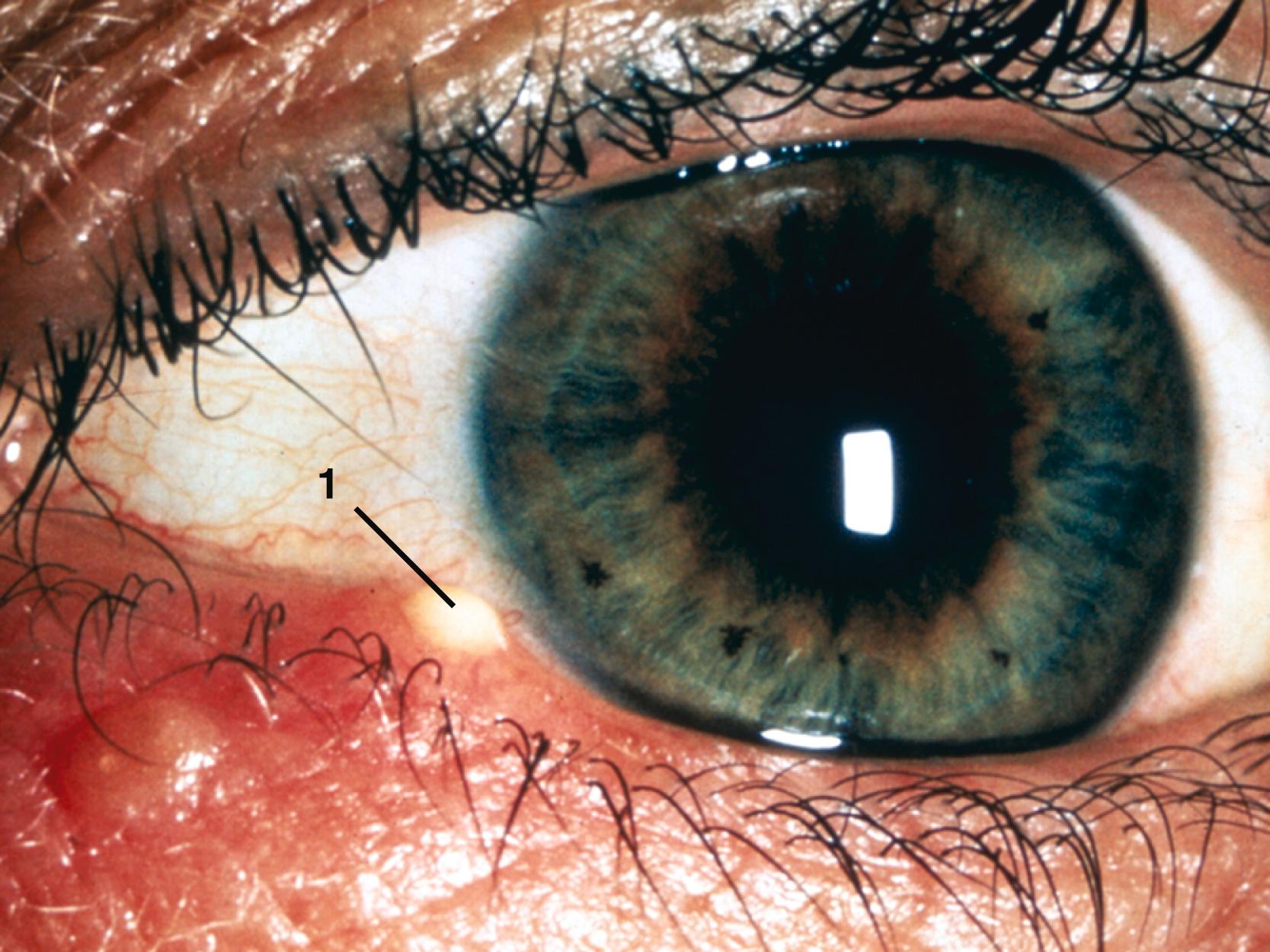
Blepharitis ( Fig. 391-9 ) is a common, nonspecific inflammation of the eyelid margin or skin. The condition is usually bilateral and symmetrical. Rosacea ( Chapter 406 ) is the most common associated cutaneous condition, and Staphylococcus aureus is the most common infectious agent. If untreated, blepharitis becomes chronic and may lead to corneal and conjunctival inflammation (blepharoconjunctivitis). Effective supportive care for blepharitis includes warm compresses and maintenance of good lid hygiene. Ophthalmic antibiotic ointment (e.g., bacitracin or erythromycin) is more efficacious than eye-drops, but systemic antibiotics (e.g., minocycline, 50 to 100 mg; doxycycline, 100 mg, once daily; tetracycline, 250 mg twice daily; or erythromycin, 250 mg three times daily) infrequently may be recommended, particularly if there is any evidence of inflammation of the cornea or conjunctiva.
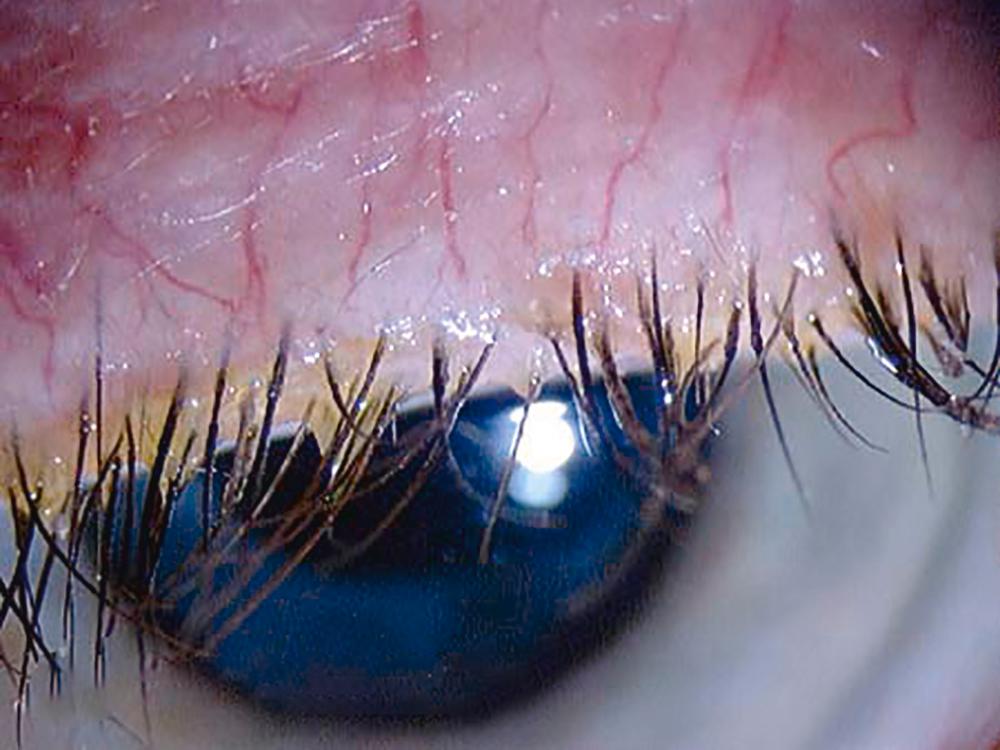
In seborrheic blepharitis, exfoliated keratinous debris accumulates along the eyelid margin, particularly at the follicles of the eyelashes, and irritates the conjunctiva. Treatment of this chronic condition is directed at mechanically removing the keratinous debris by scrubbing the eyelid and eyelashes daily with a mild detergent (“baby shampoo”) in warm water applied with a soft cloth.
Become a Clinical Tree membership for Full access and enjoy Unlimited articles
If you are a member. Log in here